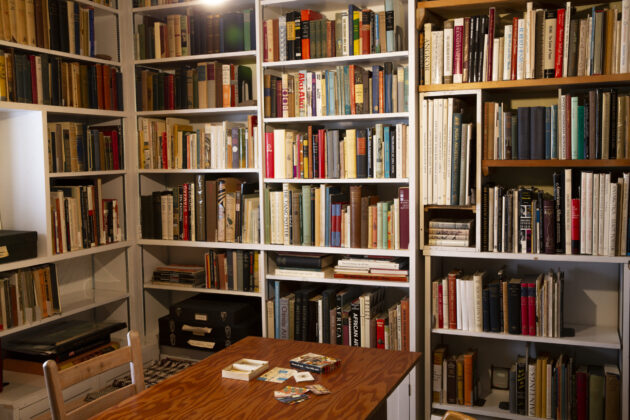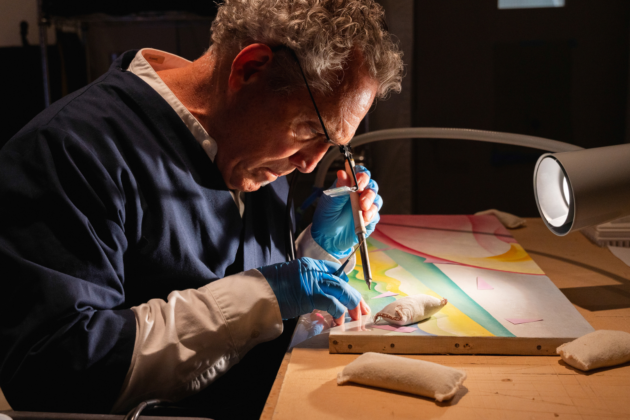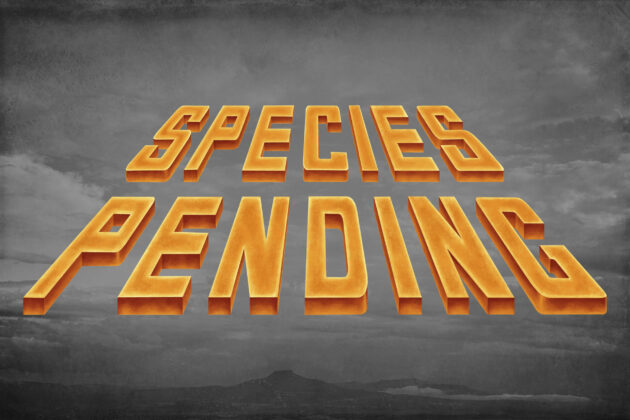
Part III: Making Friends
“Miss O’Keeffe’s Bones,” or What Became of Them [1]
When I read these magazines, reviews, and mentions, I did feel like I was sitting in a submarine. At first on the surface, looking down into dark cloudy water, I can see the shape of things; vague clouds of sand kicked up from an animal’s commotion, and an occasional fish – maybe identifiable – squirming through coral and other wilted, soggy vegetation. Similarly, I knew what people told me was below the proverbial surface, but I really knew very little. But then you submerge slowly into the archive. You see the objects you saw above water in pictures, but now you see them in the flesh, reprinted in The New York Times and accompanied with a jaded review by Edward Alden Jewell, for example. You see O’Keeffe’s work reproduced in T.S. Elliot and Marianne Moore’s periodical, The Dial in 1925, and in the popular U.S. magazine, Survey Graphic, in 1931, featuring her alongside paintings by Diego Rivera and Jose Clemente Orozco. In both instances, her paintings are paired with a story by D.H. Lawrence. And then you see the generations of critics, reviewing her shows sometimes annually, and other times over the course of four decades. You bump into figures like Henry McBride, who remained one of O’Keeffe’s most loyal followers, compulsively gushing about her every showing, thrilled by the implications of “Miss O’Keeffe’s” popularity for the success of modernism in the United States.[2]
As much as McBride recorded O’Keeffe’s annual shows, he made a ritual of following O’Keeffe’s “ladies,” her devoted and “occult” contingent from the bourgeoisie, who would gasp upon seeing the masculine carnage featured in her unusual Southwestern paintings, which he stunningly termed, “Miss O’Keeffe’s Bones,” a line that will forever amuse me.[3] Observing these ladies’ every move and reaction, McBride made the modern art gallery into a theater, where art succeeded if it inspired dramatic displays of emotion, drawing spectacular attention to the viewer and the canvas. McBride also remained a dear friend of O’Keeffe’s, attending Florine Stettheimer’s Manhattan salon together, alongside the likes of Marcel Duchamp, Frank Crowninshield, Parker Tyler, and Pavel Tchelitchew. Even after her move to New Mexico, the two continued their friendship, as he wrote, in addition to his adoring criticism of her work, frequent, animated letters of the happenings in New York City’s art scene while she stayed in New Mexico, “leaping from cliff to cliff, mountain-top to mountain-top.”[4] The critics, and O’Keeffe’s powerful vantage point in criticism, extend well beyond any singular article and the words it imparts, and into the realm of ideology, friendship, and taste.
And so the shadows of what I thought I knew, swimming below the surface, became more solid, the connections more vivid, and O’Keeffe’s work’s place in the world more graspable. Figures, like Henry McBride, turned from random names reviewing O’Keeffe’s shows into pundits, tirelessly using her art to position themselves within the vastly changing landscape of modern art. Indeed, my reading also changes. As I become more familiar with the names and personalities, I see the reviews not as fixed, singular objects that are only relevant to the shows they cover. I understand them as small excerpts from extended careers that speak equally as much to the content of the articles as do the canvases reviewed.
I have read and annotated nearly every review written during O’Keeffe’s lifetime, and I am still not sure how to understand or synthesize the critical reactions to her and her work, which grew steadily out of whispers in 1916 in New York City, to phenomenal obsession, all over the U.S. in the 1960s and 1970s. One thing that is evident, though, is the complex and intertwined nature of the webs that shape the history of O’Keeffe’s reception, the history of modernism in the U.S., the fluid ideologies and temperaments of her critics, the overflowing magazines and newspapers in which these reviews, mentions, and features appeared, and her own often elusive attitude towards these things. As always, the further I sink underwater, the deeper the water appears to go, and some things down there are just as opaque as they were from above.
This post was written by Thomas Edwards, Curatorial Intern, Marsh Family Fellow.
The feature image is a group of magazine and newspaper features composited by the author, including American Artist (June 1943), Town and Country (January 1943), House Beautiful (April 1963), and Vogue 149 (March 1, 1967).
[1] The quoted portion of this title is taken from Henry McBride’s review of O’Keeffe’s show at An American Place, which appeared in The New York Sun, January 18th, 1944.
[2] Through the 1950s, critics almost ubiquitously referred to O’Keeffe as “Miss O’Keeffe.”
[3] McBride made these observations in two separate reviews. “Georgia O’Keeffe’s Bones,” The New York Sun, Friday Feb 6, 1942, and “Miss O’Keeffe’s Bones,” The New York Sun, January 18, 1944.
[4] Henry McBride to Georgia O’Keeffe, September 27, 1929. Taken from An Eye on the Modern Century: Selected Letters of Henry McBride, eds. Steven Watson and Catherine Morris (New Haven: Yale University Press, 2000), 180.


